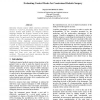Free Online Productivity Tools
i2Speak
i2Symbol
i2OCR
iTex2Img
iWeb2Print
iWeb2Shot
i2Type
iPdf2Split
iPdf2Merge
i2Bopomofo
i2Arabic
i2Style
i2Image
i2PDF
iLatex2Rtf
Sci2ools
ICRA
2000
IEEE
2000
IEEE
Evaluating Control Modes for Constrained Robotic Surgery
Minimally invasive surgery (MIS) constrains instrument motions to 4 DOF by precluding lateral motion at the incision. Robotic MIS systems can interpose arbitrary mappings between the surgeon’s motions at the master controller and the motions of instrument tips within the patient’s body. Our goal was to find the interface that was easiest to learn. We investigated the effects of different coordinate frame mappings (screen-mapped versus instrument-mapped) and master dexterities (6 DOF versus 4 DOF) by means of performance measures on simple surgical tasks. All four mode-dexterity combinations had approximately the same time-to-completion. The combination of instrument-based mapping and 4 DOF master had lower error rate and lower subjective workload. This mode most clearly reproduces the task constraints within the patient’s body.
DOF Master | DOF Versus | ICRA 2000 | Patient’s Body | Robotics |
| Added | 31 Jul 2010 |
| Updated | 31 Jul 2010 |
| Type | Conference |
| Year | 2000 |
| Where | ICRA |
| Authors | Fuji Lai, Robert D. Howe |
Comments (0)

